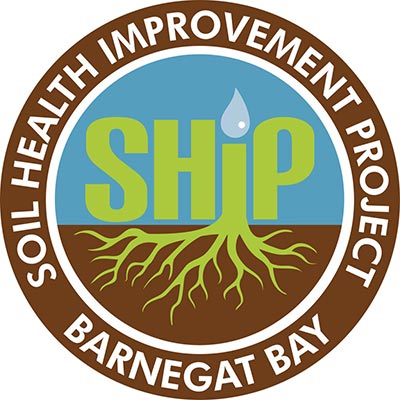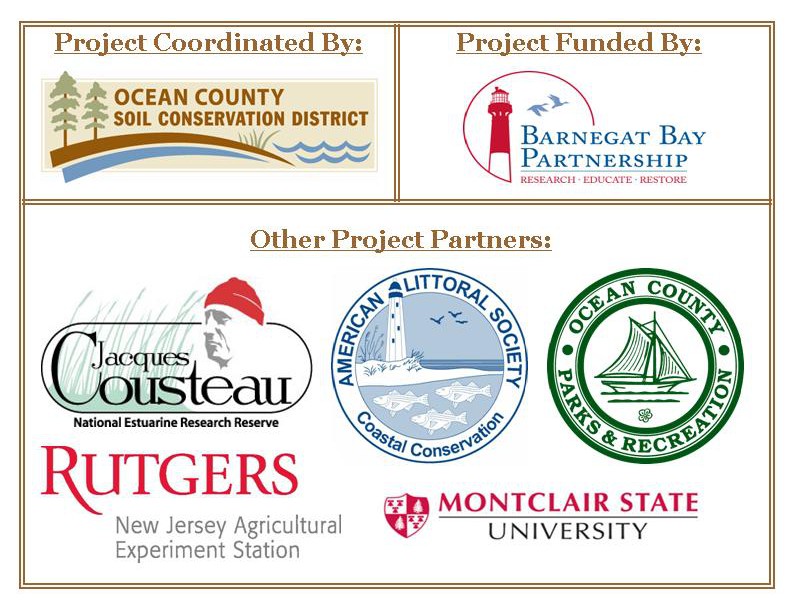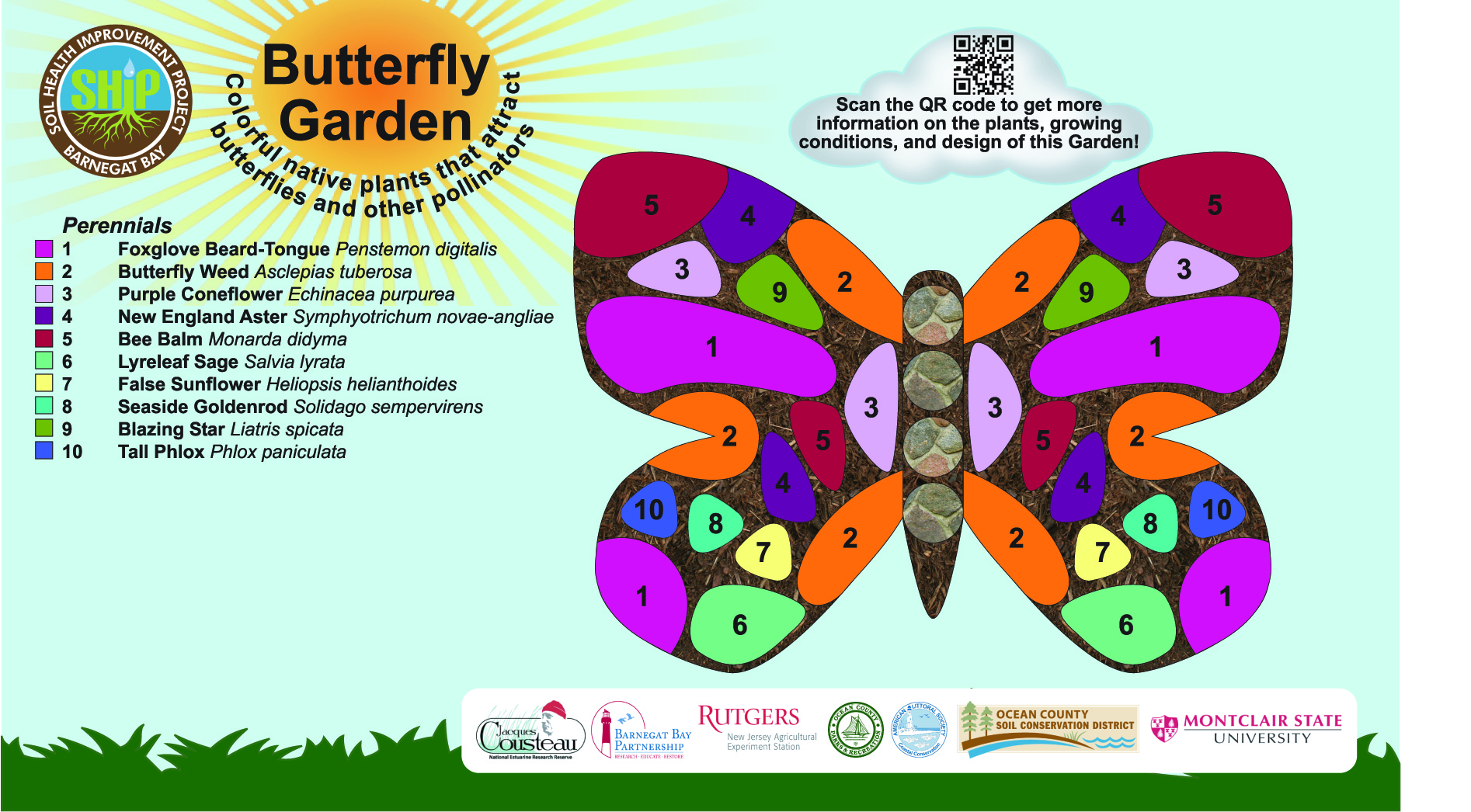What is the Soil Health Improvement Project (SHIP)?
The ultimate goal of the Soil Health Improvement Project (SHIP) was to develop simple, low cost, and practical soil restoration techniques that transferred easily to the Ocean County homeowner or professional landscaper.
Together, the SHIP partners set out to identify the optimal physical, chemical and biological properties of Ocean County’s sandy soils with a series of landscape experiments, including assessing compaction, adding organic matter, and creating 5 native plant demonstration gardens at Jakes Branch County Park in Beachwood, New Jersey.
Jakes Branch County Park illustrates two of the biggest challenges to healthy managed landscapes in the Barnegat Bay watershed: sandy soils and highly compacted soils. Because of this, the park’s grounds were an excellent place to learn which soil improvement techniques would be most useful to Ocean County residents.


The SHIP team evaluated soil health and biological activity quarterly for two years at the demonstration turf plots and native plant gardens at Jakes Branch, in addition to providing public education around soil health.
Download the slideshow used to present a webinar on “Soil Health Initiatives on Suburban Lands” showcasing the SHIP project.
SHIP Resources:
- Complete SHIP Grant Proposal
- Complete SHIP Goals and Objectives
- SHIP at Jakes Branch Fact Sheet
- SHIP at Jakes Branch Education and Outreach
- SHIP Webinar: Soil Health Initiatives on Suburban Lands
The Ocean County Soil Conservation District, Jacques Cousteau National Estuarine Research Reserve, Rutgers Agricultural Experiment Station, the American Littoral Society, Ocean County Parks and Recreation and Montclair State University teamed up to implement the Soil Health Improvement Project in Ocean County. The project was funded by the Barnegat Bay Partnership, Science and Technical Advisory Committee.
Education and Outreach Goal and Objectives of SHiP
Jakes Branch County Park will be a multifaceted demonstration site that will promote “Barnegat Bay Friendly” landscaping practices to increase visitors’ knowledge of relationships between the health of the watershed, the community, the economy and the ecosystem.
Objectives:
While participating in active and passive recreation, visitors to Jakes Branch County Park (including watershed residents, turf managers, stormwater professionals, etc.) will:
- Learn how to maintain their property through practices such as compaction reduction, organic soil amendments, low fertilizer use, native plantings, water conservation, etc.;
- Identify and select appropriate native plants for gardens, landscaping and stormwater management applications;
- Understand the ecologic and economic benefits of these practices;
- Feel empowered to encourage additional local, sustainable practices.
- Share what they learned with others;
- Appreciate the interrelated connections between the highlighted practices and healthy Barnegat Bay ecosystem functions;
- Be able to visualize an attractive alternative to a lawn;
- Become better consumers and more informed about ecosystem friendly purchasing;
- Have access to tools and techniques (via signage, literature, interpretative and instructional programs, diagrams, online resources etc.) to be able to take knowledge into action;
- Feel empowered to encourage additional local, sustainable practices.
Challenges of Ocean County Soils
Looking at existing communities within the Barnegat Bay watershed, nearly 88% of the soils may be characterized as sands and loamy sands. These sandy soils have nearly 50% pore space with rapid water infiltration rates ranging 6-20 inches per hour, equating to relatively efficient drainage. However, with land development comes soil compaction, which reduces the water infiltration rate to near zero – making these soils almost as dense as concrete. When the soil becomes this dense, our lawns and athletic fields are forced to have shallow root systems. This is problematic because these landscapes are then unable to absorb and utilize water properly, making their growth unsustainable and ultimately preventing absorption of pollutants before they enter stormwater runoff.
Why Jakes Branch County Park?
Jakes Branch County Park in Beachwood, New Jersey has some of the most compacted soil in the region. Over the long term, practices that de-compact soil and sustain adequate soil organic matter content are perhaps the cheapest and one of the most effective water conservation practices for landscapes and farmland.
Healthy soils have the ability to accept, hold and release water and nutrients to plants, helping regulate water flow to our streams and the bay. The addition of organic material is a relatively simple and highly effective method to improve the long-term health of soil. The amount and type of organic material needed to optimize soil health and thereby improve soil function, is sitespecific and dependent on a number of factors and soil properties.
What’s Being Tested?
- Soil Bulk Density
- Disturbed soils in Ocean County can be severely compacted (high soil bulk density) due to construction activities. Restoration treatments on trial turf plots will be compared for a reduction in soil bulk density (de-compaction). Additionally, restoration treatments will be compared to an untreated control soil.
- Soil Organic Matter (SOM) Content
- Excluding the litter layer, soils in Ocean County are naturally low in SOM content. Disturbance during site development typically destroys the litter layer leaving behind soil that is low in SOM. Restoration treatments on trial turf plots will be compared for increases in SOM by depth. Additionally, restoration treatments on trial turf plots will be compared to an untreated control soil. Soil organic matter content will be determined by Walkley-Black method (Nelson and Sommers, 1996) on the composite of 5 subsamples per plot collected from the 0- to 300-mm depth zone of each plot (experimental unit). Laboratory analysis of samples will be conducted by trained specialists in the Rutgers Soil Testing Laboratory.
- Soil Water Infiltration Rate
- Disturbed soils in Ocean County can be severely compacted (high soil bulk density) due to construction activities. Compaction can drastically reduce the ability of soil to infiltrate water from rain or irrigation. Restoration treatments on trial turf plots will be compared for increases in water infiltration rate. Additionally, the water infiltration rate of soil receiving restoration treatments will be compared to the water infiltration rate of untreated control soil.
- Soil Cover
- Vegetative cover of soil is an indirect indicator of soil health/quality; poor soil health is typically characterized by low vegetative cover. Restoration treatments on trial turf plots will be compared for increases vegetative by turf and the persistence of this cover over time.
Additionally, the vegetative cover of soil receiving restoration treatments will be compared to the vegetative cover of untreated control soil. Greater and persistent vegetative cover of soil will be indicator that soil health has been improved and maintained.
SHIP Task |
Responsible Party |
| Advertising, registration and marketing outreach support | JC NERR |
| Assembly of supplemental handout materials | JC NERR |
| Evaluation on the effectiveness of programs | JC NERR |
| Design and oversee native plantings | ALS – via Judy DeFiglio |
| Communicate about the project through multimedia and social networking (i.e. weekly blog writing, posting on Facebook page, special e‐announcements through email lists) | ALS – via Judy DeFiglio |
| Update web pages with pertinent information, fact sheets, links, photos | ALS |
| Write articles for the ALS newsletter (6000 members and state and federal delegations) | ALS |
| Incorporation of project information into Barnegat Bay presentations | ALS |
| Lead a local field trip to the completed project site | ALS |
| Develop a Homeowners Factsheet on amending soil with organic materials | ALS |
| Create a site profile of the Jakes Branch Soil Health Improvement Project (SHIP) on a variety of websites | RCE |
| Collaborate and assist in developing and implementing education and workshops | RCE |
| Create and conduct a “Train the trainer” workshop for Master Gardeners, park volunteers and staff and other partners to prepare individuals for giving presentation at and/or about Jakes Branch | RCE |
| Provide Jakes Branch staff with a curriculum of relevant reference materials relating to sustainable landscape and the BMPs in use at the site | RCE |
| Coordinate with Jakes Branch staff to create educational opportunities for the site | RCE |

